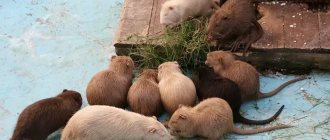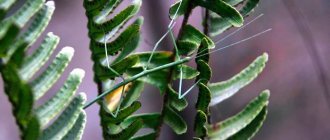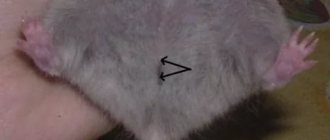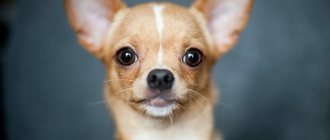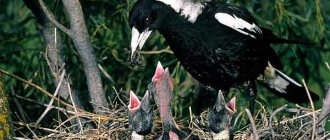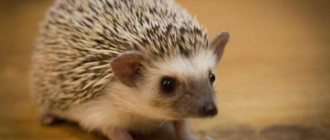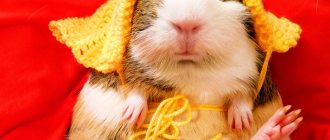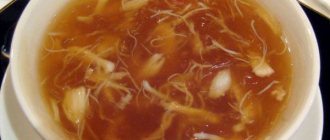Guinea pigs have long been popular pets. These cute rodents are easy to purchase in pet stores or at the Bird Market. However, the animals sold there are often outbred (crossbred) because they do not have any documents confirming their origin. Of course, this will not prevent the pig from becoming a pet, but if you plan to engage in serious breeding of these animals, then such a “breeding breeder” can please you with an unpredictably diverse offspring. For breeding, you should purchase purebred pigs of known origin. Today there are a number of clubs for guinea pig lovers that coordinate the activities of breeders and organize exhibitions. In these clubs you can purchase young animals of different breeds with pedigrees. The choice of breeds is quite large: from the already familiar smooth shorthaired, Peruvian and Abyssinian, to a variety of rare and exotic ones (curly Texels, crested Cresteds, etc.). In general, today there are more than 80 breeds of guinea pigs, differing in the structure, length and color of their coat, and thanks to the work of breeders, more and more new ones are appearing. The most popular marine breeds will be discussed in this article.
There are various classifications of guinea pig breeds in the literature. One of the most common classifications is the division of guinea pigs into three large groups - long-haired, short-haired and rare. Modern breeders also use the following option for dividing into groups:
- English Self - guinea pigs of solid color (solid color)
- Long Hair non Selfs - (Sheltie, Peruvian, Coronet, Texel, Alpaca, Merino)
- Short-haired (woolen) (Coated, non Selfs) - (agouti, American and English Cresteds, Abyssinians, Rexes, etc.).
- Rare Varieties are so-called new breeds that are still quite rare.
The range of colors in guinea pigs is also very diverse; they can be completely monochromatic (white, black, buff, red, chocolate), agoute (natural color), variegated, two or three colors, and even Dalmatians.
Origin story
These animals were made tame back in the 5th millennium BC by representatives of the tribes of South America. The ancestors of modern inhabitants of the south of Colombia, Peru, Ecuador and Bolivia at one time consumed these mammals as food. According to scientists, wild guinea pigs wanted to be close to humans without any coercion. The Incas used guinea pigs as sacrificial animals, so they were constantly sacrificed to the sun god. Animals that had a variegated brown or pure white color were very popular. It is generally accepted that modern guinea pigs descended from their ancestors "Cavia aperea tschudi", which can be found in mountainous areas.
Interesting to know! Such mammals form small groups and live in very spacious underground burrows. Animals living in the mountains of Chile have significant differences in appearance when compared with domestic guinea pigs. This is due to their food supply, which is poor in water but rich in cellulose compounds.
Reproduction
Animals can start mating at 10 months. After mating, it is recommended to remove the pig before the birth of offspring. Pregnancy lasts on average two months (the exact period depends on the number of babies). During this period, the female should be left alone.
Labor usually occurs naturally within an hour. If the pig cannot give birth, then you need to call a veterinarian. If the birth is successful, the pet will gnaw the umbilical cord itself. If this does not happen, then it can be cut with sterile instruments.
Description of the guinea pig
Zoologists note that according to taxonomy, guinea pigs should be classified as part of the family of semi-ungulate rodents, while they have a characteristic appearance and a special structure.
Appearance
It is believed that the body structure of guinea pigs is similar in basic anatomical data to most domestic animals. There are some differences noted:
- Guinea pigs have a cylindrical body. The body length does not exceed 22 centimeters, although individuals of greater length are found.
- The animal's spine consists of seven cervical, twelve thoracic, six lumbar, four sacral and seven caudal vertebrae.
- The guinea pig lacks a tail and does not have collarbones as such.
- Males, compared to females, weigh slightly more, with adults weighing from 0.7 to 1.8 kilograms.
- Guinea pigs have fairly short legs, with the front legs being much shorter than the back legs.
- The front paws have 4 toes, and the hind paws have 3. The appearance of the toes more closely resembles small hooves.
- In one week, the size of the animals’ fur increases by almost half a centimeter.
- In the sacral area of pigs there are sebaceous glands, and within the genitals and anus there are paranal glands that secrete a special secretion.
- The guinea pig's head is relatively large, with a well-developed brain.
- An animal's incisors grow throughout its life, at a rate of up to 1.5 millimeters per week.
- The lower jaw of guinea pigs is capable of moving in any direction.
- The intestines are long enough and exceed the size of the animal’s body, so food can be digested for a whole week.
Animals can have different colors, structure and length of hair, which is associated with the main natural features, therefore, there are individuals with fairly short, very long, straight or wavy hair.
Behavior and lifestyle
Being in natural conditions, wild guinea pigs prefer to be active both at sunrise and at dusk. Despite their size, the animals run quite quickly and are considered very agile, always on the alert.
The wild guinea pig lives both in forests and in mountainous areas. To arrange their nest, they look for quiet, secluded places, but they do not dig holes. To form their home, they use dry grass, fluff and thin branches of trees and shrubs.
Interesting moment! Decorative guinea pigs are used not only as cute creatures that decorate a person’s home, but are also kept at various research institutions as experimental animals.
Wild animals are quite social, so they live in the same territory with many of their relatives. Each flock has several males, at the rate of one male for a couple of dozen females. The animals are quite active, so keeping them at home requires sufficient walking space. Pets rest (sleep) more than once a day, often with their eyes open.
How long does a guinea pig live?
Being in the natural environment, wild guinea pigs can live no more than 7 years, and at home, if all rules and regulations are followed, 2 times longer.
Guinea pig - All about the rodent species | Type of rodent - Guinea pig
Pet health
The animals have strong immunity, so infectious diseases rarely bother them. They usually appear if the pet often walks outside or if one of the household, including other animals, gets sick. Common infectious diseases include:
- skin infections;
- salmonellosis;
- toxoplasmosis;
- ringworm;
- coccidiosis.
In addition, a pet can be harmed by physical injury or a violation of the diet: spoiled or poisonous foods, intolerance (allergy) to some component. In this case, cystitis, conjunctivitis, and neoplasms are possible. Foods prohibited for pigs include:
- dairy products;
- products of animal origin;
- sweets;
- flour;
- cooked food from the common table.
The first sign that your pet is feeling unwell is a decrease in appetite or refusal to eat. In such cases, you should find out the reason for this behavior as soon as possible and take action. Prolonged hunger strikes lead to exhaustion of the body and worsening of the disease.
Guinea pig breeds with photos
Guinea pigs are quite popular pets, so recently many new breeds have been artificially bred. The most popular include:
Alpaca
The breed is characterized by the presence of thick, beautiful, curly and long hair. These pigs have two rosettes located on the back, and one, which has an irregular shape, within the forehead. In the area of the muzzle, the hairs grow so that they form a kind of sideburns. On the legs, hair grows from bottom to top.
Texel
The breed is characterized by the presence of beautiful curly hair, which in appearance is similar to a wet perm. Due to its unique and attractive coat, the breed is very popular both here and abroad.
Abyssinian
It is considered one of the oldest and most beautiful breeds. This breed has a hard coat, and also has several rosettes consisting of fairly long hairs. Such pets have an excellent appetite, and the animals themselves are characterized as very active.
Merino
The breed is characterized by a number of characteristics, including large eyes and ears, as well as a short head and a strong, compact body. The breed has long and curly hair, developed cheeks and pronounced sideburns. A symmetrical and small “crown” can be seen on the animal’s head.
Peruvian
The breed has a long and very attractive coat that does not require any special grooming process. To prevent too long coats from becoming too dirty, guinea pig owners use special papilettes for this.
Rex
It is a variety of short-haired breeds with a coat of a special structure. As a result, the guinea pig resembles a small, living plush toy. The hair on the back and head is coarser than on the rest of the body.
Cornet
This breed has other names, such as “crested” or “wearing a crown”, which is associated with the presence of a peculiar crown between the ears of the animal, formed by a special rosette. The coat is long and evenly distributed throughout the body. The Cornet breed was born as a result of crossing the Sheltie and Crested breeds.
Sheltie
The breed has long and straight hairs with a silky shine. In the head area there is a kind of mane that falls over the shoulders and onto the back of the animal. Animals are born with short hair, and already in six months they have a full coat of hair.
Interesting to know! Baldwin guinea pigs have a very exotic and unusual appearance because they have no fur. On the animal's knees you can see several medium-length hairs.
The most popular breed among short-haired guinea pig breeds is the Self breed. This breed has a solid color, and the number of colors is amazing. With the slightest movements of the animal, many tones are reflected, which creates unique color tints.
PROS and CONS of keeping GUINEA PIGS / SvinkiShow
Coronet
The Coronet came from the Crested and the Sheltie. The result is a breed with a very unusual coat: there is a rosette crown on the head, and there are partings along the back in different directions. The impression is as if an invisible hand is constantly combing the rodent.
Coronets are affectionate, kind, and very trusting. They willingly make friends with children and allow themselves not only to be stroked, but also to experiment with their fur.
Keeping at home
After acquiring an animal, its behavior can be quite sluggish and ambiguous, as the animal gradually gets used to the new living conditions. During this period, the guinea pig has a poor appetite, it is frightened by various movements and sounds, so it can sit motionless in one place for a long time. The adaptation process can and should be accelerated by creating a certain atmosphere in the home, characterized by calm and attention.
Cage, filling
In fact, guinea pigs are considered to be quite timid by nature, so they react negatively to changes in their living conditions. Animals can be kept either in a terrarium or in a cage with a tray, with the second option being more preferable. In the cage, it is necessary to provide something like a resting house (for sleeping), as well as place various game elements, a feeder and a drinking bowl. Naturally, the size of the house should take into account the size of the animal itself.
Care, hygiene
Guinea pigs do not tolerate both cold and excessive heat in the form of direct sunlight, so it is necessary to protect your pet from these negative factors. Water treatments are provided to the guinea pig as needed. Once a week you should brush your coat. Since the claws are unlikely to wear down naturally, they should be trimmed once a week.
If an animal participates in exhibition shows, then such a pet requires special attention. From an early age, they should be taught to sit still in one of the postures, and they should also be taught to patiently endure the daily processes of brushing. In this case, the animal must withstand the process of using the pills. Wire-haired and smooth-haired guinea pigs undergo periodic trimming.
What to feed
In the natural environment, guinea pigs eat components of plant origin, which include roots and seeds of plants, leaves, and fruits that have fallen from trees or shrubs. The basis of the diet of a domestic guinea pig is high-quality hay, which normalizes the functioning of the digestive system and also allows the rodent to grind its teeth. Due to the peculiarities of the digestive system, hay should be given to your pet quite often, but in small portions.
Good to know! Experts recommend feeding guinea pigs with ready-made food, at a rate of no more than one tablespoon per day.
Naturally, no one would recommend feeding a guinea pig exclusively with hay, so its diet should include succulent food in the form of berries, fruits and vegetables. As a treat, you can offer the animal sweet fruits, berries and the fruits of other cultivated plants. In order for the animal's teeth to constantly wear down, the animal must receive twigs of a cherry or apple tree, dandelion or celery root. The guinea pig's cage must contain fresh, clean water, and it must be changed every day.
Guinea pigs are exclusively herbivores, so any food items of animal origin should be excluded from the diet. In addition, it is not recommended to feed the pig milk, which can lead to upset of the animal’s digestive tract, since its body does not digest lactose well. The use of low-quality feed, as well as frequent and, especially, drastic changes in diet contribute to the development of various ailments, and often cause death.
Health, diseases and their prevention
The most common diseases that guinea pig owners may encounter are:
- Worms and external parasites.
- Alopecia or hair loss, which is the result of improper feeding of the animal, stress, lack of vitamins and minerals, as well as the appearance of parasites.
- Injuries and even fractures of limbs, which is associated with violation of maintenance rules.
- Rickets as a consequence of a lack of vitamin D.
- Colds (ARI), pneumonia, otitis media and cystitis, as a result of hypothermia or drafts.
- Anomalies of dental incisors.
- Disturbances in the digestive system. As a result, the animal develops diarrhea, constipation, flatulence or enteritis.
- Keratitis and conjunctivitis, as a result of exposure to infections, chemical and mechanical factors.
Improper nutrition (imbalance of nutritional components) leads to excess weight in your pet, which does not lead to anything good.
Reproduction and offspring
At the age of six months, you can already start mating guinea pigs. This process is possible within 2 weeks, while fertilization is possible within 8 hours. After pregnancy, the female carries her future offspring for about 2 months.
From 2 to 5 cubs are born, which are well developed and move independently. For a couple of months, the female feeds her cubs, but not longer.
Nutrition
It is important to know what guinea pigs eat so that there are no health problems for your pets. In nature, the rodent feeds on seeds, berries, leaves and roots.
At home, pigs need to eat hay and ready-made balanced feed. For dessert, you can give him nibble on fresh vegetables, salad and fruits.
To allow teeth to be ground down, cherry branches are placed in the cage. It is more convenient to pour water into the sippy cup every day, so it will not spill and will provide the pet with the necessary moisture.
Where and how to buy a guinea pig
As a rule, show and breeding class animals are the most expensive, since they are the ones who participate in exhibition shows and are the basis of any nursery or breeder. Pet-class pets are inexpensive and accessible to citizens of any category.
The cost of animals includes various factors, such as gender, quality, color, and origin. Imported animals cost at least 15 thousand rubles, since transportation is not cheap at all. Regardless of origin, the pig must be absolutely healthy, well-fed and very active. The eyes and nose should be clean, and the coat should be well-groomed, without scratches or bald spots.
Owner reviews
Naturally, high-end guinea pigs are inaccessible to ordinary buyers. In any case, if you plan to breed them, you should opt for purebred specimens.
Interesting to know! In our country, guinea pig breeding has not yet reached such a high level as abroad. Despite this, true connoisseurs of these animals try to acquire individuals that have an attractive and exotic appearance.
It should also be remembered that you cannot cross long-haired and short-haired representatives of the breeds, since the result will be offspring that are low-quality mestizos and no one will allow them to be shown at exhibitions. On top of that, crossing different breeds is also unacceptable because it hinders the improvement of the breed data of any of the species.
Guinea pigs have earned the right to be considered one of the most sought-after pets. Ease of care and maintenance is acceptable for everyone, even novice owners. This is an affectionate and sociable animal that is perfect for families with children.
Other care
- Your guinea pig's nails need to be trimmed as they grow.
- It is often not worth bathing an animal. Pigs are clean.
- Long hair is brushed once a week.
- Clean the cage every 4 days and whenever it gets dirty.
- The body must be examined for injuries, cuts and parasites.


